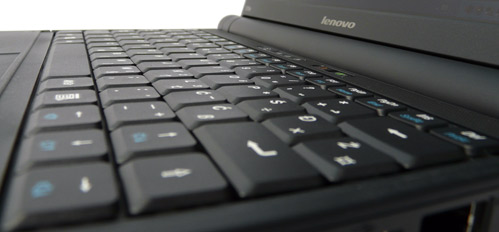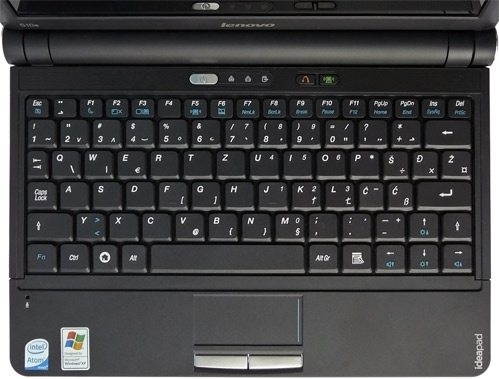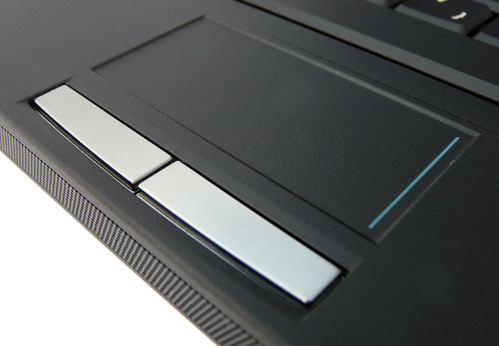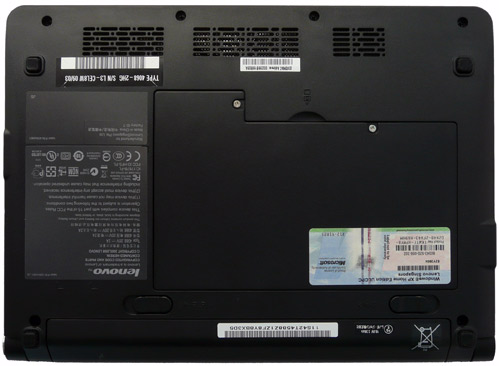Index
Keyboard and Touchpad
We
already said the S10e has a surprisingly small footprint, and this has
a somewhat negative impact on the keyboard. Although the chassis itself
is small, the designers decided not to extend the keyboard all the way
to the edges. This basically resulted in a keyboard which is half way
between that of a 9-incher and most 10-inch netbooks. It is still
pretty comfy to use, although people with big fingers should be wary, although those people should avoid all small notebooks in the first place.

Someone
made the baffling decision to move the Control key one position to the
right, and place the Fn key in its place. This will result in a number
of failed copy/pastes until you get the hang of it. The Tab key is
tiny, and so is Enter. Another non-keyboard related issue is microphone
placement. You can see it just above the Atom sticker, and it's easily
covered by your palm, so if you're into Skype, think about a headset.

Fortunately, the
arrow keys are full size, and more importantly, the keyboard feels
bulletproof. There's no flex, no squeaks and twists. As we always like
to point out, you'll eventually get used to just about any layout, but
you'll never get used to poor quality. Also, bear in mind that the
layout differs from market to market, so be sure to check what it
actually looks like in your neck of the woods.
The
touchpad is also quite small, measuring just 26x57mm. However, it has a
scroll bar, it's pretty fast, and we got used to it in no time. Using it to zoom in or out is a bit tough due to the size. It can be
done with a little practice, but there's not much room for error with
just an inch of vertical space.

The
keys are a bit too small for my chunky thumb, but after a couple of
days I got used to them. At least they're under the touchpad, and not
on the sides, and there's no complaints about the quality whatsoever.
Ergonomics
Although some vendors offer three USBs on their netbooks, Lenovo has
just two. We can't say this is a big drawback, especially as there's a
USB on each side of the chassis. Let's take a look at the layout.

The power connector, memory card reader, VGA are on the left. The USB
is a bit close to the front edge, but this doesn't really make much of
a difference on such a small machine.

On the right side you'll find the second USB, as well as LAN and audio
connectors. Also, Lenovo is one of few vendors to include an
ExpressCard 34 slot on their netbooks, although it's doubtful many
people will choose to use it. Still, it can come in handy. The security
lock is hidden in the hinge cover.

On the front there's nothing to report. Just three status LEDs and a
decorative mesh covering two speakers. They are pretty weak, even for a
netbook.

And on the back, there's absolutely nothing, apart from the battery.
Our sample came with a 3-cell battery, but all S10e SKUs on the
European market ship with a 6-cell power pack. It offers twice the
juice, but also gives the IdeaPad a pretty big hump on its backside.
The latches seem pretty tough, and keep the battery safely in place
without a hint of flimsiness.

Another nice touch is the no-nonsense upgradeability, as its intestines
are easily accessed through a spacious plastic lid. This is not the
case with many netbooks. Add to this the ExpressCard 34 slot, and the
S10e is easily the most upgradeable unit on the
market. In case you were thinking about changing the OS, be warned that
you'll have a tough time making the SSD work.
Under load, the S10e tends to get pretty hot, especially around the
HDD. We were looking at more than 37°C after running a few benchmarks.
Sounds like a lot, and it is, but netbooks aren't really meant for any
CPU intensive tasks anyway, so this shouldn't be a problem for the
average user.
